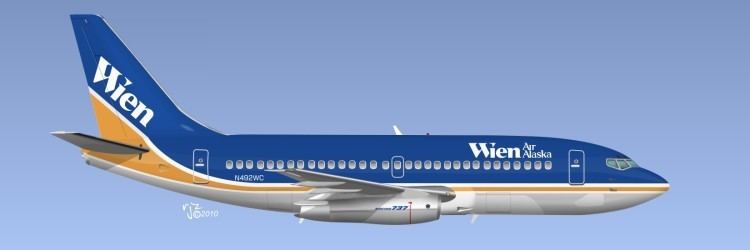Commenced operations June 1927 Date of operation June 1927 | Ceased operations 1985 Key person Noel Wien | |
 | ||
Wien air alaska commercial historical 1980
Wien Air Alaska (IATA: WC) was a United States airline formed from Northern Consolidated Airlines (NCA) and Wien Alaska Airways. The company was famous for being the first airline in Alaska, and one of the first in the United States.
Contents
- Wien air alaska commercial historical 1980
- Wien air alaska 1980 tv commercial
- History
- Timeline
- 1920s
- 1930s
- 1940s
- 1950s
- 1960s 1970s Prop and turboprop
- 1960s 1970s Jet
- 1980s
- Destinations in 1984
- Incidents and accidents
- References
Wien air alaska 1980 tv commercial
History
Noel Wien flew an open-cockpit biplane, a Hisso Standard J1 from Anchorage, Alaska's "Park Strip" to Fairbanks, Alaska on 6 July 1924.
In 1925, Wien purchased a Fokker F.III monoplane with a cabin built in 1921 in Amsterdam for the Fairbanks Airplane Company, and it was shipped to Seward, Alaska, by boat, then shipped in pieces via the Alaska Railroad to Fairbanks. Ralph Wien, Noel's brother, came with him, to work as a mechanic. They assembled the Fokker F.III Monoplane in Fairbanks.
Noel taught Ralph how to fly in 1924. Ralph was killed on October 12, 1930, while flying a diesel-powered Bellanca Bush plane with Fr. Philip Dolen, Superior general of Alaskan Catholic missions, and Fr. William Walsh, a diocesan priest from Oakland, California, on board.
The airline was started in June 1927 by Noel and Ralph Wien in Nome, Alaska, but traces its roots back to their 1924 to 1926 flights out of Fairbanks with Bennett Rodebaugh's Fairbanks Airplane Company, which was later absorbed into Wien Alaska Airways.
His brother Sigurd Wien was a mechanic from 1935 to 1937, when Noel taught Sig how to fly. Starting in 1937, Sig was also a bush pilot. Sig managed the Nome Office and flew the North Slope bush flights. Sig Wien, as a bush pilot, flew contracts for USGS geologic exploration activities including geologist Marvin Mangus. Sig Wien became CEO of Wien Airlines after his brother Noel Wien retired from management activities [1940 to 1969].
Expansion came at a price, as Wien was pushed to the brink of bankruptcy. Household Finance, controlling owners since 1979, then dumped its investment in the airline and sold the company to Wien’s President, Jim J. Flood, in 1983. He shut down the airline, and on November 23, 1984, Wien was liquidated for profit. Noel's son, Merrill, said the end of his family's airline came when it "was bought by a corporate raider on a leveraged buyout and was liquidated for about twice what the stock was selling for. The Airline Deregulation Act of 1978 made this possible." in an interview with Avweb.[2]
Before Wien Air folded in 1985, they were known as the second-oldest airline in the United States.
The company pioneered jet service to gravel runways, and helped develop the Boeing 737-200 Combi aircraft configuration which allowed mixed freight and passenger loads on the main deck of the aircraft. By the early 1980s, their route network extended from Point Barrow in north to dozens of Alaskan communities as well as to cities in the lower 48 states in the western U.S. including Albuquerque, Phoenix, Oakland, and Denver. Their main bases were located in Anchorage and Seattle.
Noel Wien's son flew in an open cockpit biplane from Anchorage's 'Park Strip' to Fairbanks on July 6, 1999, to commemorate the 75th anniversary of his father's solo flight in a Hisso Standard J1. The municipality of Anchorage allowed the reenactment plane to take off from the grass park, which was used as a runway in 1924.
Timeline
1920s
1930s
1940s
1950s
1960s & 1970s: Prop and turboprop
1960s & 1970s: Jet
1980s
Destinations in 1984
By March 1984, Wien Air Alaska had expanded its scheduled passenger flights into the western U.S. in addition to continuing to serve many destinations in Alaska. All of the cities in the lower 48 states were served with Boeing 727-200 and/or Boeing 737-200 jetliners at this time. Some smaller destinations in Alaska were served with commuter turboprop aircraft. The following destination information is taken from the March 2, 1984 Wien Air Alaska system timetable route map.
Wien also previously served Juneau, AK (JNU), Ketchikan, AK (KTN) and Whitehorse (YXT) in the Yukon Territory of Canada with Boeing 737-200 jet aircraft.
Incidents and accidents
On December 2, 1968, Wien Consolidated Airlines Flight 55, a Fairchild F-27B, crashed into Spotsy Lake, Pedro Bay, Alaska. All 39 people on board were killed.
On August 30, 1975, Wien Air Alaska Flight 99, A Fairchild F-27B, crashed on approach to Gambell, Alaska. 10 of the 32 passengers and crew on board were killed.
